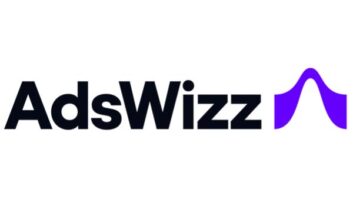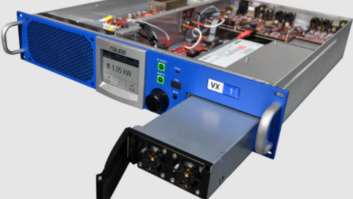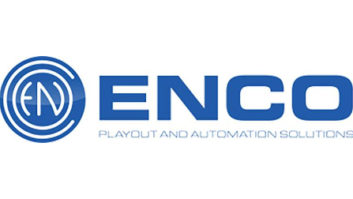Social media and online services notwithstanding, local radio remains a vital source for emergency information. While the connected car and cloud-based services garner press notice, terrestrial radio usually provides the most redundancy, and its signal remains a constant, even during extreme environmental conditions.

An HD Radio receiver displays an e911FM test message, broadcast by Seattle partner KIRO(FM). Allen Hartle, president of Jump2Go, is set to launch e911FM, a preparedness initiative that delivers Emergency Alert System messages, National Oceanic and Atmospheric Administration National Weather Service reports and Amber Alerts to terrestrial radio and social media.
He believes the service provides a unique level of redundancy. He said e911FM applies “a dual-technology approach, using both cloud-based infrastructure and, most importantly, FM RDS/HD Radio data delivery. During an actual emergency, as cellphone service fails, the e911FM service continues to function via our FM radio data capability. Today’s Web-based, connected car solutions cannot say the same.”
PUBLISH ONCE
Founded in 1992, Jump2Go is a Seattle-based datacasting company whose products enable radio stations to reach out to listeners through billboards, dashboards, mobile devices and, most recently, RDS and HD Radio tuners.
This is not Jump2Go’s first venture into emergency broadcasting. In 2012, the Federal Emergency Management Agency’s Integrated Public Alert and Warning System and NPR Labs hired the company to build an FM RDS Emergency Alert System to assist hard-of-hearing and deaf listeners. The project involved creating a custom RDS protocol and custom hardware. It was installed in 26 Gulf state radio stations in 2013, as Radio World has reported.
After the FEMA/NPR project was completed, Jump2Go expanded its cloud-based Alert Aggregation System. In addition to EAS emergency and weather alerts, the company received authorization from The National Center for Missing and Exploited Children to broadcast AMBER Alerts. This expanded aggregation system forms one of the cornerstones for e911FM.
Development of the aggregation framework presents challenges. The FEMA system uses an XML markup language and is complex, but the overarching philosophy is to publish an event once and disseminate it to many platforms. Once alerts are received, they need to be stored in a database and checked for the expiration time.
The e911 data aggregation system is being developed in Java, due to the ease with which it works across platforms. When development is complete, it will be moved to a server environment on a Linux platform. Before the system goes online, it will be rolled out in stages and tested. The IPAWS and EAS parts will come first, followed by Amber Alerts. Each service will be tested end-to-end for correct operation. East and West coast servers are maintained, both for redundancy and load balancing purposes.

Jump2Go President Allen Hartle is using these images to explain the e911 concept.SYSTEM OVERVIEW
While there are a number of moving parts in the e911FM system, the basic overview is simple. Participating stations have a JumpBox installed; it connects via an Internet connection between Jump2Go’s data aggregation center and the station’s RDS encoder, HD Radio Exporter and HD Radio Importer.
The aggregation server collects, sorts and indexes the incoming alert data. When an alert occurs, the aggregation system tells the JumpGate system that it has alert data in-play. Then the JumpGate platform server queries the aggregator, fetches the alert and forwards it onto the Shape Social Twitter process.
Alerts will be sent from Jump2Go’s Data Aggregation Center to the various media outlets. On the broadcast side, e911FM will use an RDS Open Data Application to embed alert information into the RDS data for presentation in the connected car. HD Radio “Active Alerts” are also planned. Stations will be able to control the frequency and amount of time that these alerts are active, according to Hartle.
On the social media side, Jump2Go partnered with Shape Social, which developed a Web service that integrates with Jump2Go’s platform to take alerts and push them out into social media. “It is a perfect synergy to use social media like Twitter to have these alerts going viral,” said Hartle. “Countless numbers of people are made aware of an alert that they may missed without e911.” To receive alerts via social media, smart phone users need to be subscribed to the participating station’s Twitter account.
The e911FM alert text is also inserted into artist and title fields in streaming and online services including iHeartRadio, TuneIn and NextRadio. For now, the service is text-based. Hartle said that in the future, graphics such as the Amber Alert logo may be added.
The initial test stations in Seattle and New Orleans have Jump2Go’s JumpGate hardware installed and running. The JumpGate data processor is a compact network appliance that manages communications between broadcast systems and the company’s Web-based information technology. Additional locations were selected based on emergency/extreme weather potential, and include locations in the Gulf states, eastern seaboard and Hawaii. Oklahoma and Texas were selected as the center of tornado alley, and Los Angeles was picked due to its potential for earthquakes. Cox, Greater Media, Beasley, Radio One, Entercom and Hubbard are scheduled to take part in the testing.
Hartle said one big task remains. “The Amber Alerts work with Zip codes for location. We’re mapping FCC station call letters with ZIP code databases. On-air tests have been awaiting completion of the data aggregation part of the system. Hartle adds, “Alerts from the National Weather Service and FEMA IPAWS are now in the system, but Amber Alerts are still being added.” He hoped to complete the data aggregation trials in early March, with on-air tests to follow.
The e911FM service will be made available free to Jump2Go’s JumpGate customers who subscribe to data lookup services which are triggered by automation and station program events. Customers pay $75–100 per month depending upon the services to which they subscribe. Single-station customers can purchase a JumpGate with a first year of service for $700.












